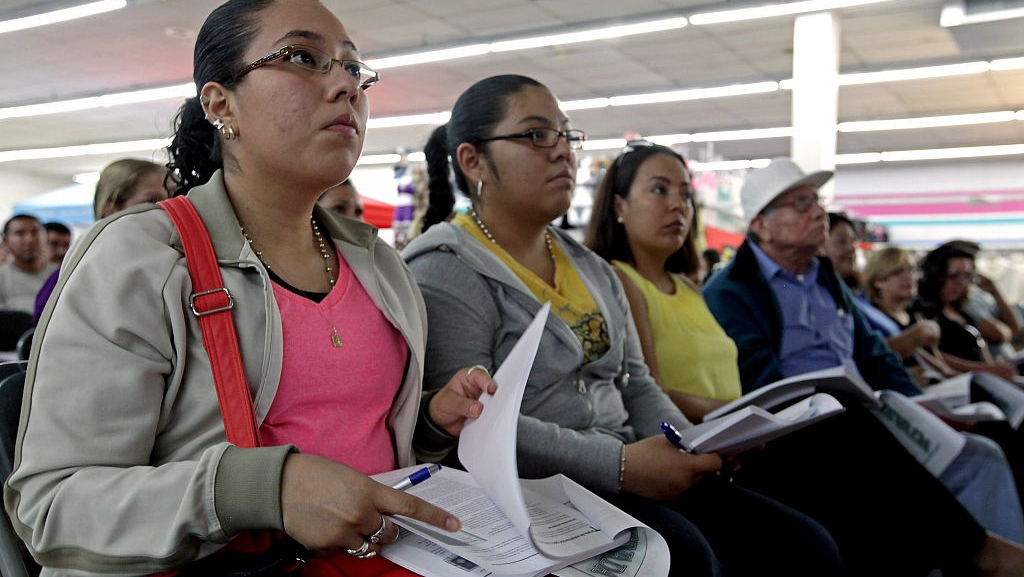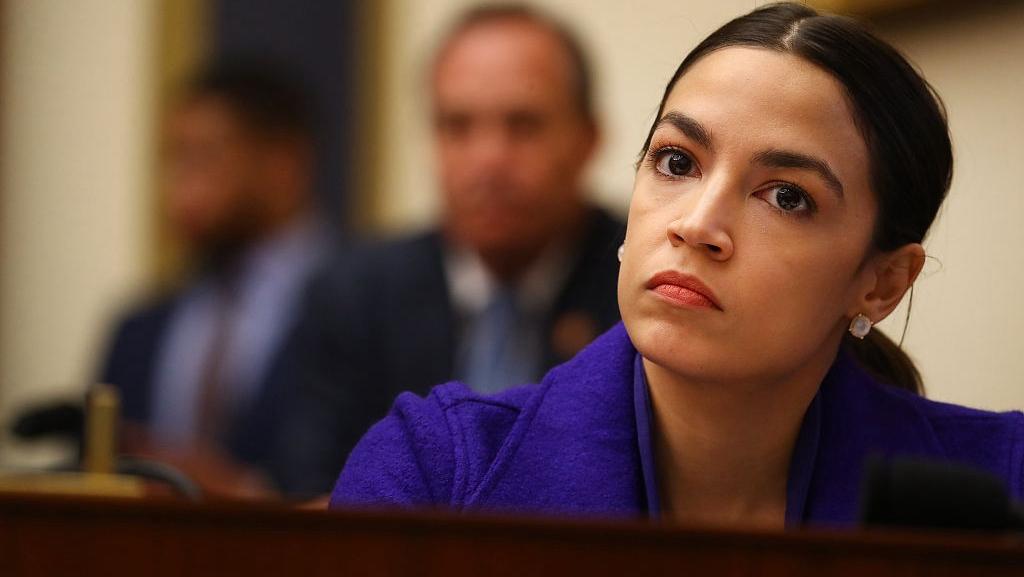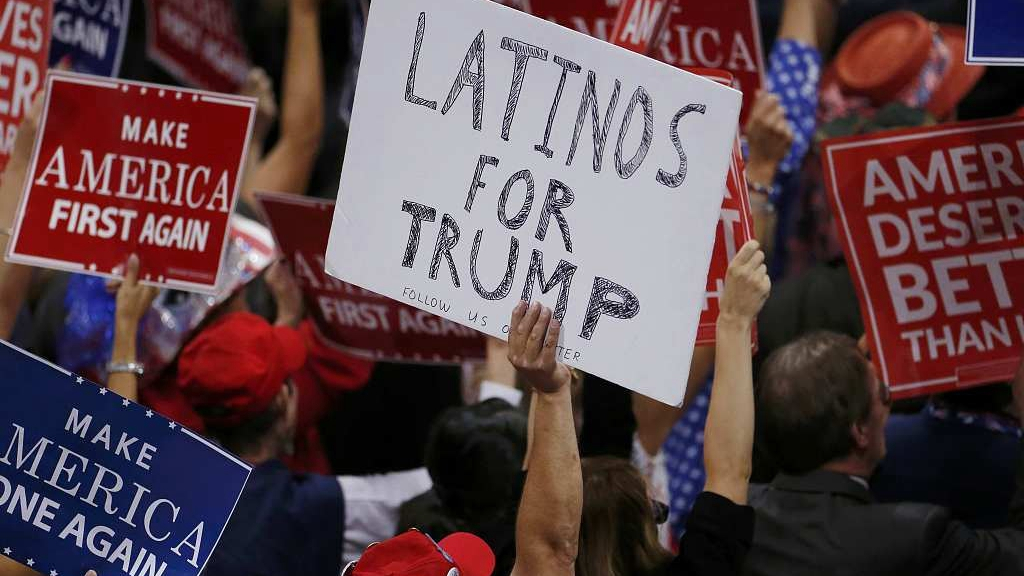

Hispanic voters are predicted to surpass blacks as America's largest ethnic minority bloc at the 2020 presidential elections, so their views on the presidential field are likely to be ever more sought after.
Donald Trump's attack on Mexicans as "rapists and criminals" during the 2016 presidential race and his relentless focus on building a border wall to keep out a Latino "invasion" have also kept pollsters interested in how he fares among this demographic group.
And the latest national survey makes grim reading for the president. It found that 73 percent of Latinos across the U.S. plan to vote or are leaning toward voting for a Democrat next year.
Only 16 percent plan to back Trump, according to the Univision poll.
Exit polls suggested that the Republican standard-bearer won 28 percent of the Hispanic vote three years ago, though some experts believe the figure could be lower because exit data doesn't always properly capture minority voters. Some 66 percent said they cast ballots for Hillary Clinton.
About 32 million Hispanics are projected to be eligible to vote in 2020, compared with 30 million blacks, marking the first time that Hispanics will be the largest racial minority group among the electorate, according to the Pew Research Center.

Democratic member of the House of Representatives Alexandria Ocasio-Cortez has helped to raise the profile of Hispanics in American politics. /VCG Photo
The population growth among Hispanics, in particular, is helping to drive the non-white share of eligible voters in the U.S. to what's projected to be a third, the highest ever. Asians are another group that is rising, to an estimated 11 million eligible voters.
In the opinion poll, 22 percent of the Hispanics surveyed said they are planning to vote for Joe Biden, the front runner in a crowded Democratic field, with 20 percent opting for Bernie Sanders. All of the main hopefuls are well ahead of the White House incumbent.
When it comes to direct matchups, Biden is ahead of Trump by 71 percent to 15 percent with Sanders having a 71 percent to 18 percent lead.
Anti-immigrant language
Yet another poll published in August suggested that the Democrats still have a lot of work to do to translate that apparent support into actual votes. It found that among those who identified as Democrats, only 57 percent said they were certain to vote in the Democratic primary elections next year.
"Our poll shows that the vast majority of Latino voters are worried that things will get worse for them, and for immigrants, if Trump is re-elected," said Clarissa Martinez-De-Castro of UnidosUS, a national Latino advocacy group.
Pollster Matt Barreto told reporters that Trump's anti-immigrant language was among issues pushing Hispanics to pay more attention to the president’s agenda.
That is an important consideration because historically, the engagement of Latinos with politics in America hasn't kept pace with their demographic growth.
But that showed signs of changing in the 2018 midterms.

A sign reading 'Latinos for Trump' is held up at the Republican National Convention in Cleveland, Ohio, July 20, 2016. /VCG Photo
The U.S. Census Bureau reported in April that the Hispanic turnout rose by 13.4 points from the 2014 midterms to 40.4 percent last year.
The chairman of the Democratic Congressional Campaign Committee, Ben Ray Lujan, credited Latinos at the time with playing a "pivotal role" in the Democrats taking back the House of Representatives.
And this week, in reflecting on the midterms, Barreto said, "In 2018, we saw one of the most significant gains in registration and turnout. So I believe we have really turned a corner through a combination of the levels of anger ... as well as the increased mobilization that parties and candidates are now doing. So I do believe you will see a very robust and high turnout in 2020."
That is important. According to Pew, the number of Hispanic eligible voters who didn't vote has exceeded the number of those who did vote in every presidential election since 1996.
Democrats are hoping that the anger of which Barreto spoke, will drive them to polls to vote against Trump, who triumphed last time out in spite of the "racist" rhetoric that many thought he would tone down after he took office.
Florida danger for Trump
Perhaps more damaging for the president is the result of a separate poll in Florida that gave him only 12.9 percent support among Hispanics in the swing state.
The Latino vote in Florida is significant because it accounts for a sizeable 18 percent of the electorate.
Trump won Florida in 2016 with just 112,911 more votes than Hillary Clinton.
Pollster Eduardo Gamarra called the poll figure a "historical low for a Republican candidate."
"If the voter turnout rate of Hispanics is high here, Trump runs the risk of not winning," Gamarra told Univision.
The killing in August of 22 people in the border city of El Paso, one of the deadliest hate crimes in American history against Latinos, has also hardened positions in the community against Trump.
But it remains to be seen whether the apparent concentration of his campaign efforts among white men will be enough this time to withstand the general disdain for him among Hispanic and other minority groups.
Top Photo: Sisters Jacqueline Sandoval, (left), and Alexandria Sandoval take notes on a Spanish copy of the Nevada Drivers Handbook at a class to teach Latinos in the U.S. how to drive at the Eastern Indoor Swapmeet April 26 , 2015 in Las Vegas, NV. The class was funded by the Koch brothers to get the Latino vote for Republicans. /VCG Photo

Copyright © 2018 CGTN. Beijing ICP prepared NO.16065310-3
Copyright © 2018 CGTN. Beijing ICP prepared NO.16065310-3